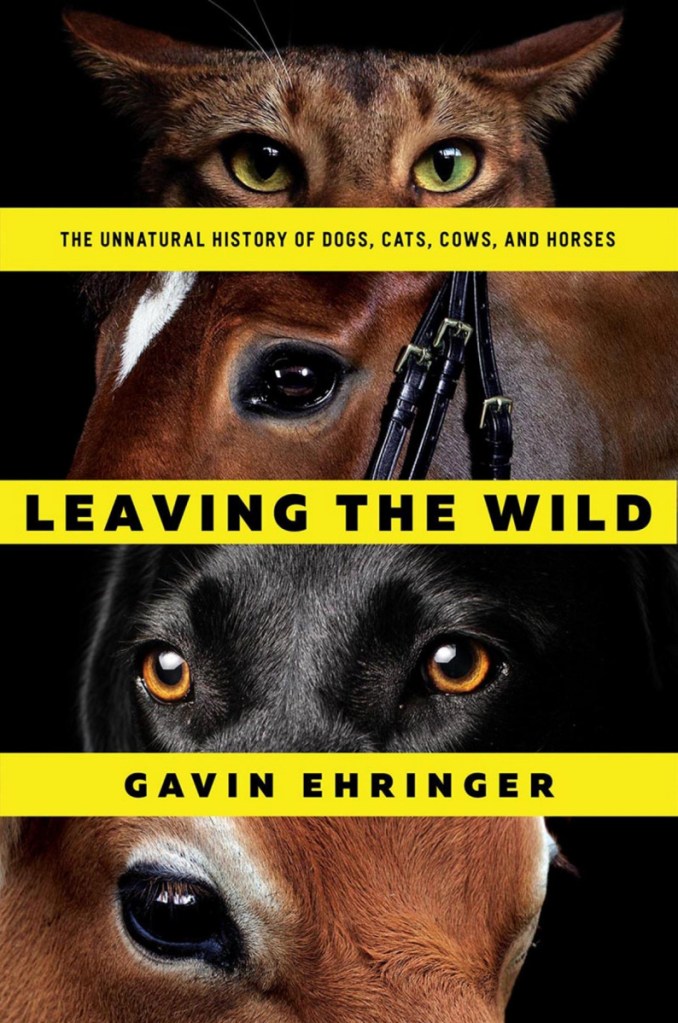In 2016, a German shepherd that won best in breed at a celebrated British dog show “was shown on television crabbing around the ring, her sloping back hunched over,” writes Gavin Ehringer in “Leaving the Wild: The Unnatural History of Dogs, Cats, Cows, and Horses.” The Daily Mail pointed out that the dog exhibited “a painful looking, out of step gait.” The animal was able to win the breed competition but did not seem to have a very healthy existence. The Royal Society for the Prevention of Cruelty to Animals said it was “shocked and appalled” at the dog’s condition. An ensuing outcry led to an updating of the breed standard for shows: The dogs now had to be “capable of standing comfortably and calmly, freely and unsupported in any way.” As Ehringer dryly notes: “Being able to stand seems like a low bar to set for any dog breed, much less one celebrated for their heroism by both sides during the Second World War.”
Through four case studies, “Leaving the Wild” reveals the extent to which humans over the millennia have drastically altered domesticated animals’ lives and created ethical quandaries that are now difficult to resolve. Beginning with dogs, Ehringer notes that two-fifths of the half-billion dogs alive on the planet are free-ranging village dogs, not under human control. Of the remainder, German shepherds aren’t the only dogs harmed by designer breeding. Dachshunds have been elongated to the extent that they suffer from intervertebral disc disease, while pugs, boxers and bulldogs are so flat-faced that they experience breathing troubles.
Unlike dogs, cats today “remain little altered in appearance from the wildcats from which they sprang.” That Egyptians worshipped cats and Europeans in the Middle Ages massacred them are well-known facts, but Ehringer throws in some fascinating, unexpected cat history, such as the rise of kitty litter and its role in cat-keeping. He amusingly describes what he calls the “feline zeitgeist” of today’s internet and offers that cats are more independent and better suited than dogs for the social-media-obsessed, fast-paced, apartment living of millennials.
Ehringer’s tales jump around in time, sometimes to dizzying effect. The horse chapter takes us on a chaotic tour from Genghis Khan’s 13th-century Mongolia to the nomadic Bedouins 4,000 years ago, then abruptly to President Ronald Reagan’s signing of a law that gave horse-breeding tax shelter status in 1980. The law set off a frenzied competition in which, for some wealthy Americans, “the Arabian in their stall was like the Rolls Royce in their garage.” Six years later, the law was changed, and many horses, no longer so profitable, were loaded into trucks and sent off to slaughter. Ehringer provides a scattered chronology to make his points about the many uses and abuses of horses through history.
Of the four animals Ehringer discusses, only cows (and their products) are widely consumed. The author visits three dairy farms of various sizes in search of “happy cows” and extols the virtues of drinking milk. But he seems insensitive to the larger point. Even cows handled with compassion dwell inside a system that considers them first and foremost as commodities. At Bob Bansen’s Emerald Veil Jerseys in Oregon, Bansen knows every cow by name, doesn’t demand peak production and keeps cows past age 12, longer than the standard in the dairy industry. Yet he looks at a cow with low-hanging udders and comments, “I’ll have to sell her off soon.” Male calves in the industry are routinely sold off as veal. As Ehringer notes, “Regardless of when, virtually all dairy cows end up being slaughtered for the dinner plate.”
Ehringer doesn’t shy away from controversy. He’s in favor of breed-specific legislation for “inherently vicious” pit bulls, a position guaranteed to rile animal advocates who insist that the methodology for compiling comparative attack statistics across breeds is highly flawed because of breed prejudice. He even suggests that U.S. dog shelters are overpopulated because of pit bulls and that the extinction of the breed would be no loss. On the other hand, he’s a moderate on the “Cat Wars” question, that is, the impact that domestic cats – a category including pets, strays, and feral or unsocialized cats who survive free-ranging on their own – have on birds and other small animals in the wild and what should be done about it. Ehringer focuses mostly on feral cats and recognizes that trapping, neutering and returning them to their communities can be highly effective in reducing that population. Based on attempts to eradicate feral cats in Tasmania, Ehringer says, lethal cat culling won’t work: It’s the boldest territorial cats that are killed, leaving room for new cats to rush in and increasing the numbers of cats who hunt.
As a cowboy, horseman and dog trainer, Ehringer brings an engaging voice to his topic. But the absence of footnotes and a bibliography makes it difficult to evaluate the credibility of his arguments. At times his word choices are unconvincing, as when he describes a pit bull’s killing of a child as “murder.” It’s also distracting to see the names of some scholars and cities, as well as other words, misspelled. In sum, there’s a light touch at work here, sometimes too light, in describing the sometimes loving, sometimes greedy ways humans have altered the lives of so many animals.
Send questions/comments to the editors.



Success. Please wait for the page to reload. If the page does not reload within 5 seconds, please refresh the page.
Enter your email and password to access comments.
Hi, to comment on stories you must . This profile is in addition to your subscription and website login.
Already have a commenting profile? .
Invalid username/password.
Please check your email to confirm and complete your registration.
Only subscribers are eligible to post comments. Please subscribe or login first for digital access. Here’s why.
Use the form below to reset your password. When you've submitted your account email, we will send an email with a reset code.